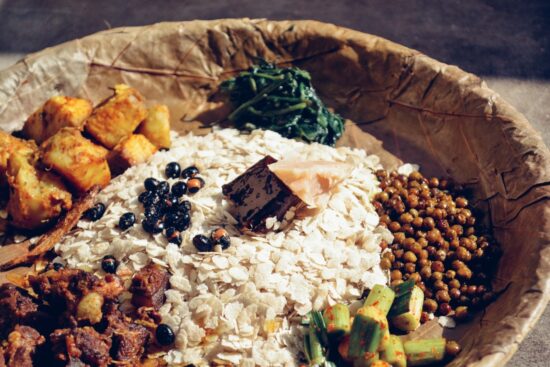It makes a meal of the day when hot served rice with a bowl full of tangy flavored Gundruk ko jhol is served. Right then, you dive into your hot plate with your hands mixing and mashing the two ingredients. That’s what a Nepali’s mouth water for. There are many other ways to prepare Gundruk, capable to please your diet.
Most of we Nepali people crave for Gundruk. It is also famous among the Diasporas all around the world who feel nostalgic when someone mentions Gundruk. It is considered as one of the national Nepali dishes. Tourists visiting Nepal are also enthusiast about tasting the dish and compliment the typical Nepali taste.
The history of Gundruk comes from long ago when farmers would store their food for the non-harvesting time of the year. Usually, in the month of October- November Gundruk is mass-produced. Out of many other fresh foods that were stored, fermented green leaves were a good idea for stocks. It is very genuine to Nepali taste and is enjoyed by people on all geographic reasons. On a round figure, every year almost 2,000 tons of Gundruk is made in Nepali households. You can either buy them or make them on your own.
Raw Materials
Gundruk is made from fermented leaves of radish, spinach, turnip, mustard or cauliflower. It is a hygienic source to obtain minerals during the off-seasons. Each vegetable’s leaves have a distinguishing flavor. The taste of Gundruk depends on the amount of acidity it gains throughout the fermentation process.
The leaves are allowed to wilt for at least one or two days. They are then shredded into medium pieces with a knife. If it is a radish, their roots are also mixed together for even better taste. Then the smashed leaves are kept in a glass jar container, clay pots or earthenware container. The container must be compressed and closed tightly, without letting the air pass through. Now it is time to acquire some heat, so the containers are kept in someplace sunny or open space.
The fermentation takes a while to form its acidity. Once the materials start to give some tangy smell the container could be checked and compressed more and more. After a few days or even a week, acidity could form as required. It is then time to dry the material by spreading them in sunlight on a plastic sheet. It takes about 2 or 3 days to dry completely if sufficient sunlight is obtained by it. Gundruk is finally ready to cook.
Gundruk is not the only fermented food in Nepalese culture. There are also Sinki and Taama that are popular food available. They are also prepared in similar ways providing tangy taste once the acidity is formed.
Gundruk Dishes preparation
Gundruk is served as a side appetizer or as a pickle in most Nepali meals. There are lots of ways to enjoy Gundruk. Bhatmas compliments the best on any Gundruk dishes. However, in modern days Gundruk is also experimented as a flavor and added to some dishes to give it a typical Nepali taste.
Gundruk ko Jhol
Ingredients: Gundruk, fried bhatmas, oil, 1 chopped onion, 1 chopped tomato, turmeric power ½ tablespoon, red chilies and salt (as per taste).
Process: Soak Gundruk in water for at least 10 min. Heat oil and add some turmeric powder. Fry the chopped onions, tomatoes, chilies. Drain up soaked Gundruk and fried bhatmas and add some salt in it and mix them all. Then put 2 cups of water and leave it to boil for 10 min. Serve hot with cooked rice.
Sadheko Gundruk
Ingredients: Gundruk, cucumbers, salt, chilly powder, mustard oil, chilies, salt, raw mustard oil.
Process: Mix them all together and serve it with any meal.
Gundruk ko Achaar
Ingredients: Gundruk, fried bhatmas, salt, chilly powder, and raw mustard oil.
For achar: 6 -8 half boiled tangy tomatoes, salt, ½ cumin and coriander powder (jiraa and dhaniya), pinch of turmeric powder, Sichuan pepper (timur).
Process: Mix all the ingredients for Gundruk first. And for achar, grind all the ingredients. Serve Gundruk and Achar separately and mix them while eating.
Gundruk as flavor
Gundruk has now even been used to add flavors to your favorite food. For instance, Gundruk tastes better with Instant white noodles. Prepare a soupy noodle and add some soaked Gundruk in it for a Nepali taste. You can also try it with other fried noodles, chowmin or thukpa recipes.
The Diasporas around the world are always in search of Nepali taste. In China, there are some white noodles available that contains the flavor of fermented vegetables and tastes somehow like Gundruk. In fact, Chinese cuisines include such flavors to most of their dishes but the Nepalese are unaware of this.
“I miss eating Gundruk so much but we don’t really time to make them at home or go for searching Gundruk in the stores near,” tells Surag Pandit who has been living in Australia for past few years. If someone is traveling to Nepal we ask them to bring some, he adds.
Most of the people living away from Nepal crave for Gundruk than any other. There are some Nepali stores available but it is very rare that they supply Gundruk. Even the tourists are attracted to the taste of Gundruk that they often carry them to their home countries or learn the Gundruk making process.
You may be interested

Evoke Cafe & Bistro Jhamsikhel Menu + Photos Gallery
gyve - February 14, 2021Evoke Cafe & Bistro Jhamsikhel Menu Evoke Food Menu: Evoke Photos Gallery:

Newari Food list: Popular Items in Kathmandu
gyve - February 14, 2021As one walks along the alleys and corners of the Kathmandu Valley, one is bound to get mesmerized by the aura of the freshly cooked Newari dishes.…

Five Best Pizzeria Places in Kathmandu
gyve - September 7, 2020Pizza is one of the famous fast food in the whole world. Everyone knows or has heard about pizza. Pizza is dish that originated in Italy which…































Leave a Comment